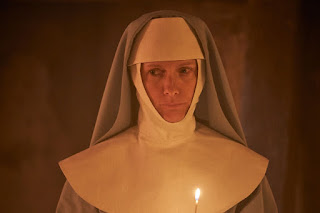Netflix's Dracula Episode #1
Dracula is an iconic tale that has been told in many different versions since the original book was published in the nineteenth century. One of the most recent adaptations is a television show called Dracula on Netflix. Although the story is basically the same, there are many significant differences that stuck out to me between the original novel
and the TV show.
 |
| Younger Dracula |
As soon as the show starts, we see the TV show stray from the novel as the scene opens with Jonathan Harker waking up in a nunnery. The show continues on to tell the story of Harker's time within Dracula's castle, through flashbacks, as Johnathan explains to the nuns what he experienced. I prefer this way of telling the story because it allows the audience to better understand what is going.
As the show progresses, it becomes very clear that Johnathan is already dead and Dracula has drained him of his blood before he even left Dracula's castle. During the flashbacks to Dracula's castle we see that The Count is becoming more young the longer he feeds off of Harker. Dracula's youth returning to him is eluded to in the original novel, but the show makes this very prominent as it is a different, younger character each time.
 |
| Jonathan Harker with a fly in his eye |
A very significant difference from the novel, is that Jonathon "ached" for Mina in his dreams during his time at the nunnery. However, he could not remember what she looked like to the point that he did not realize she had been sitting right across from him the whole time the nun was interviewing him. Regardless if Mina was dressed as a nun or not, it is very unusual that a man does not remember the face of the love of his life.
Gender was portrayed in an interesting way throughout the show Dracula. The nuns in the show played a huge role. They were showed in a positive light, like they were strong and independent. The nun that was interviewing Jon was very outspoken and at one point stated, "Perhaps like most women, I am trapped in a loveless marriage in order to maintain a roof over my head." (Referencing to her relationship with God.) I thought this was very significant because no women, especially on of the nuns, would have talked like that in the original novel. Netflix's Dracula did, however, do a stereotypical view of a women through their portrayal of one of Dracula's brides. She was a younger woman that seemed to be very angry and was begging for more blood. This is an accurate representation of a younger woman, even though she was "un-dead," she was very needy and emotional, which can be a stereotype for women.
 |
| One of the outspoken sisters in the nunnery |
Bram Stoker's Dracula is a very iconic novel that has influenced countless genre's of entertainment and created a lasting imprint on me. However, I cannot help but to prefer Netflix's TV show version of the story. As I was watching the show I realized that there was an underlying element of humor throughout, especially with the way Dracula was portrayed. His character was very sarcastic and often said some backward comments that could be portrayed as funny. I enjoyed this aspect of the show because it made it easier to watch and much more entertaining. With that being said, I still think it is very important to acknowledge the impact the original novel, Dracula has made in modern literature and film.
Clip from Hotel Transylvania 2, one of the many films influenced by the original Dracula



I think it's very interested that the female character the show chose to portray in a stereotypical fashion is in a partnership with Dracula. There is this idea of the "psycho girlfriend" that permeates pop culture. These types of characters are showed as overly emotional, clingy, and even unstable, much like you described the bride. Even in 2020 and among positive portrayals of women, certain harmful stereotypes are continually perpetuated.
ReplyDelete